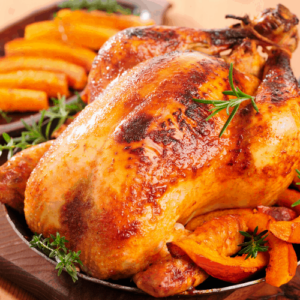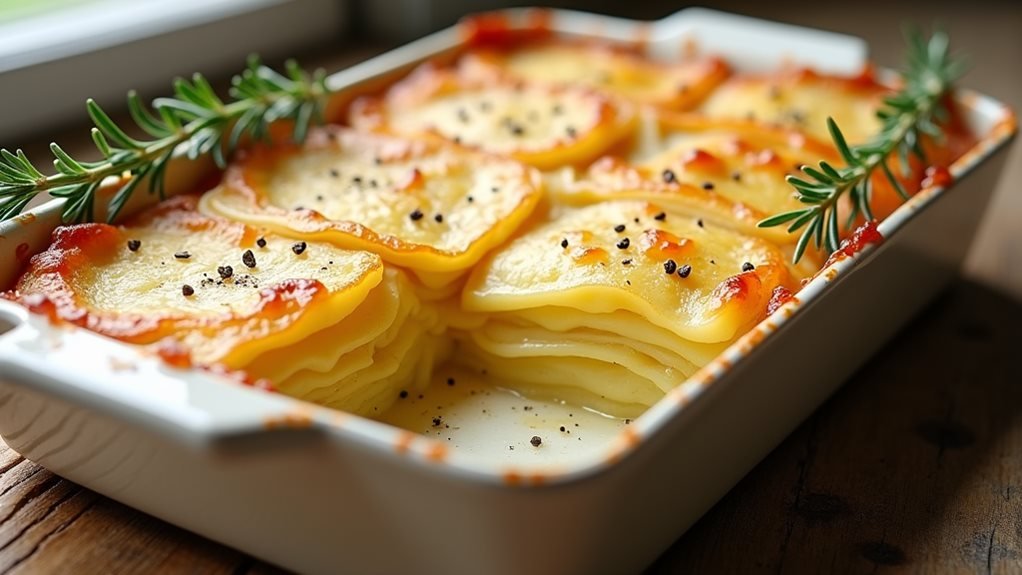When creating a comforting classic like roast chicken, remember that the secret to achieving that desirable golden, crispy skin and succulently moist meat lies in the cooking technique and the bird’s quality. It’s wise to choose a free-range chicken, known for its richer taste due to their superior diet and the freedom to roam, which contributes significantly to the flavor and texture of your dish.
Drawing on wisdom from Gordon Ramsay to master perfectly roasting a chicken. Juicy chicken begins well before the oven preheats. Brining your chicken, either with a traditional wet brine or a dry one, is a key step. This not only seasons the bird thoroughly but also helps maintain moisture during cooking, leading to more tender meat.
Caribbean flair on your plate: Experience the heat with Gordon Ramsay’s Jamaican Jerk Chicken: Fusion of Fire and Flavor.

Roast Chicken Stuffed with Chorizo Recipe
Ingredients
For the Chicken
- 1 chicken whole chicken (about 4 to 5 pounds)
- 2 tablespoons olive oil
- Salt and freshly ground black pepper to taste
For the Chorizo Stuffing
- 1/2 pound chorizo, casing removed and crumbled
- 1/2 cup cannellini beans, drained and rinsed
- 1 small onion, finely chopped
- 2 cloves garlic, minced
- 1/2 cup breadcrumbs
- 1/4 cup chicken broth or white wine
- 1 tablespoon fresh parsley, chopped
- 1 teaspoon smoked paprika (optional)
- 1 Lemon to Stuff
Instructions
- Preheat the Oven: Preheat your oven to 375°F (190°C).
Prepare the Chorizo Stuffing:
- Over medium heat, cook the chorizo in a skillet until it browns.
- Add the onion and garlic to the skillet and cook until the onion is soft and translucent.
- Stir in the cannellini beans, mixing well with the chorizo, onions, and garlic.
- Remove from heat and stir in the breadcrumbs, chicken broth or white wine, parsley, and smoked paprika. Mix well.
Stuff and Prepare the Chicken:
- Rinse the chicken and pat it dry with paper towels.
- Loosen the skin from the breast and thigh areas and stuff the chorizo mixture under the skin. You can also fill the cavity with some of the stuffing.
- Truss the chicken, securing the legs and wings as needed.
- Rub the outside of the chicken with olive oil and season generously with salt and pepper.
- Roast the Chicken: Place the chicken in a roasting pan, breast side up.
- Roast in the preheated oven for about 1 hour and 20 minutes, or until the juices run clear and a thermometer inserted into the thickest part of the thigh reads 165°F (75°C). Basting occasionally with pan juices can help keep the chicken moist.
- Rest Before Serving: Once the chicken is cooked, remove it from the oven and let it rest for 10-15 minutes before carving. This helps the juices redistribute, making the chicken more tender and flavorful.
- Carve the chicken and serve it with side dishes, such as roasted vegetables, a salad, or potatoes.
Video
Notes
Italian classic redefined: Enjoy a gourmet version of a beloved dish with Gordon Ramsay Chicken Parm: Gourmet Twist on an Italian Classic.
Why Put Stuffing in a Chicken?
Putting stuffing in a chicken serves multiple purposes. Firstly, it adds flavor to the meat from the inside as the juices from the chicken permeate the stuffing, creating a delicious, savory taste. Secondly, it efficiently uses the cavity space, allowing an additional dish to be cooked simultaneously with the chicken. Thirdly, stuffing can absorb some of the chicken’s moisture, resulting in a moist stuffing and a roast that is less likely to dry out.
Is It a Good Idea to Cook Stuffing Inside a Chicken?
Cooking stuffing inside a chicken can be a good idea if done correctly. It is important to ensure that the stuffing reaches a safe internal temperature of 165°F (74°C) to prevent foodborne illness from bacteria such as Salmonella. Overstuffing should be avoided as it can lead to uneven cooking. Some prefer to cook stuffing separately to ensure the chicken and stuffing are cooked thoroughly and reduce the risk of bacterial contamination.
Why Put a Lemon in a Roast Chicken?
Putting a lemon inside a roast chicken can infuse it with a citrusy flavor, which complements the savory taste of the meat. The lemon also releases moisture as it heats up, which can help keep the chicken moist during cooking. Additionally, the acidity of the lemon can help tenderize the meat. As the lemon cooks, it can also contribute to a subtle, fresh aroma.
Should You Baste a Roast Chicken?
Basting a roast chicken involves spooning the pan juices over the chicken during roasting. This is thought to add flavor and prevent the skin from drying out, resulting in a juicier and more flavorful bird. However, some chefs argue that basting is unnecessary because opening the oven door causes heat loss, which can lead to longer cooking times and potentially drier meat. Basting can also soften the skin, whereas not basting can help achieve a crisper skin. Whether or not to baste is a matter of personal preference and the desired outcome for the roast chicken.







